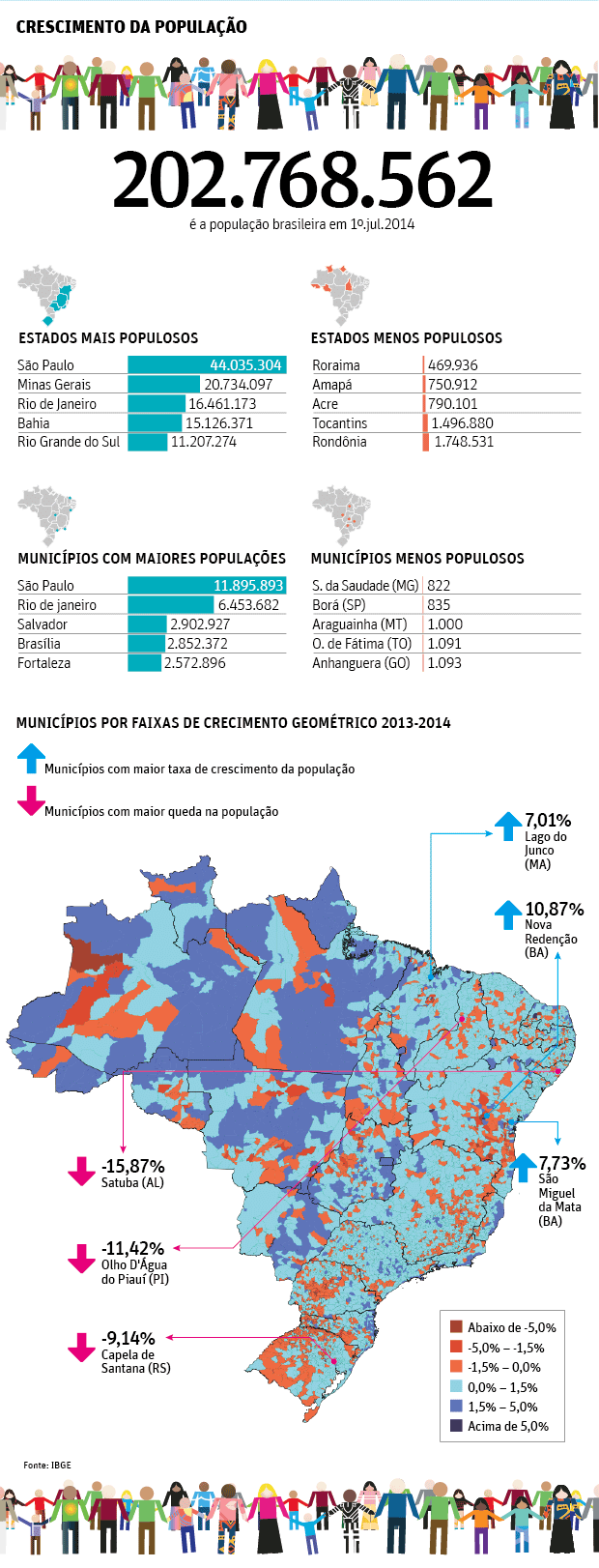Latest Photo Galleries
Brazilian Markets
17h34 Bovespa |
-0,32% | 124.741 |
16h43 Gold |
0,00% | 117 |
17h00 Dollar |
+0,38% | 5,1487 |
16h30 Euro |
+0,49% | 2,65250 |
ADVERTISING
Brazil's Population Reaches 202.7 Million
08/29/2014 - 08h45
Advertising
LUCAS VETTORAZZO
FROM RIO
Brazil's population reached 202.7 million in July, according to IBGE estimates announced on Thursday (28). Population grew 0.86% in the period, totaling 1.7 million people.
The most populated cities -more than 500 thousand inhabitants- grew below average, with a 0.84% increase.
Cities with 100 and 500 thousand inhabitants grew by 1.12% and those with 50 and 100 thousand increased 1.02% in the period.
For researcher Luciano Gonçalves, from IBGE, the growth of smaller cities strengthens the thesis that, besides having saturation at major city areas, there is migration into the countryside.
Three hypotheses explain this movement. The first is economic dynamism achieved through the countryside in recent years, with the establishment of factories and mills.
The second would be that the people who leave the countryside towards big cities searching for employment choose to settle in cities of the metropolitan area due to the high value of real estate in the capital.
The third and final hypothesis is that residents have decided, when getting older, to leave major urban areas, generally more violent than the countryside.
Several cities in Bahia are on the list of places with population reduction. Gonçalves explained that this was due to demarcation of certain areas in the state last year, which interfered with the population count.
"All of these effects, however, are external and not part of the Brazilian demographics that, in recent years, has shown a mismatch between birth and population ageing."
Although currently the natural growth of the population (difference between births and deaths) is positive, IBGE estimates a big change.
Population, says Gonçalves, has aged more rapidly: today we have 32 seniors (65 years old) for every 100 children born. In 2000 the proportion was 18 to 100.
The forecast is that by 2037 this ratio is one to one. This will, for example, impact Social Security, since with the Brazilian model, the young contribute to pay for the retirement of the elderly.
STATES AND CITIES
São Paulo remains the most populous state in the country with 44 million inhabitants. Minas is the second, with 20.7 million, followed by Rio, with 16.6 million.
In the cities, the logic is repeated: São Paulo is the largest city, with 11.9 million people, followed by Rio (6.5 million), Salvador (2.9 million), Brasilia (2.9 million) and Fortaleza (2.6 million).
Translated by SIMONE PALMA
Read the article in the original language
| Editoria de Arte/Folhapress | ||
 |



